We may earn a commission if you make a purchase through the links on our website.
The Best ActiveBatch Alternatives
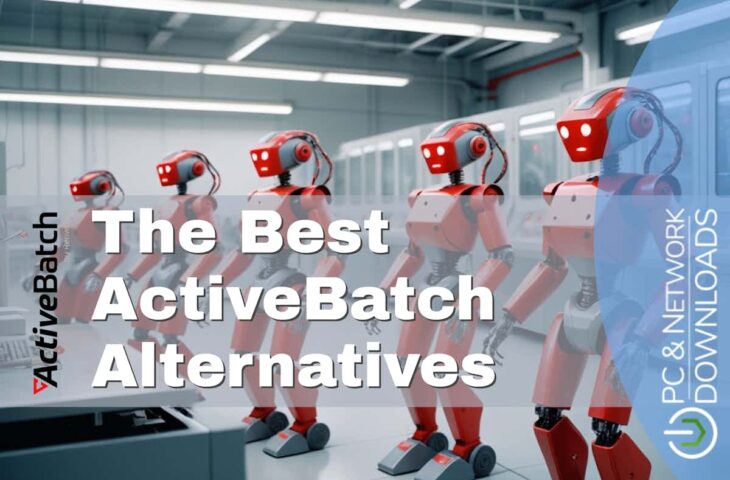
UPDATED: May 10, 2024
Find the best product for your automation demands with these alternatives to an automation king.
ActiveBatch is a widely employed automation system that brings a lot to the table, however, there are a lot of automation products on the market. Knowing how well ActiveBatch stands against its competition can be difficult, considering the sheer quantity of features and integrations these services boast. What’s more, Redwood—the holders of ActiveBatch—has another automation platform called Redwood RunMyJobs that they proactively advertise as being superior, with numerous migration options available. To assist you in finding the best alternative to ActiveBatch, this article drills down the gargantuan list of automation solutions to present the best options.
Here is our list of the best ActiveBatch alternatives:
- Redwood RunMyJobs With RunMyJobs' consumption-based pricing system, you are only billed when the service is active, and the cost is constantly modified to reflect your operational budget. This is quite helpful for firms where scalability and flexibility are important considerations, which is frequently the case for enterprises that use a lot of automation.
- AutoSys Workload Automation AutoSys Workload Automation optimizes the availability of critical application workloads across your organization by dynamically responding to in-the-moment business events, aligning workload processes with SLAs, ensuring constant monitoring, and automating recovery.
- Stonebranch With a similar set of functions packaged through a very user-friendly user interface, Stonebranch offers another SaaS alternative to ActiveBatch, greatly simplifying the process of implementing automation throughout your company. Stonebranch provides a broad range of pre-configured automated connectors.
The ones that have been selected aren’t just excellent automation systems; they are also similar to ActiveBatch, while also providing a unique enough angle to distinguish themselves from the competition. This means that you can’t go wrong in choosing any of the ones on this list, and you’ll probably be instantly familiar with them if you’re migrating from ActiveBatch. Each product comes with a specialized unique selling point that makes it stand out from the others, choosing the best product for your business demands will likely come down to a combination of pricing, and these unique features.
However, first, let's start by discussing exactly what ActiveBatch brings to the table, so we can better compare it to some alternative products.
Activebatch
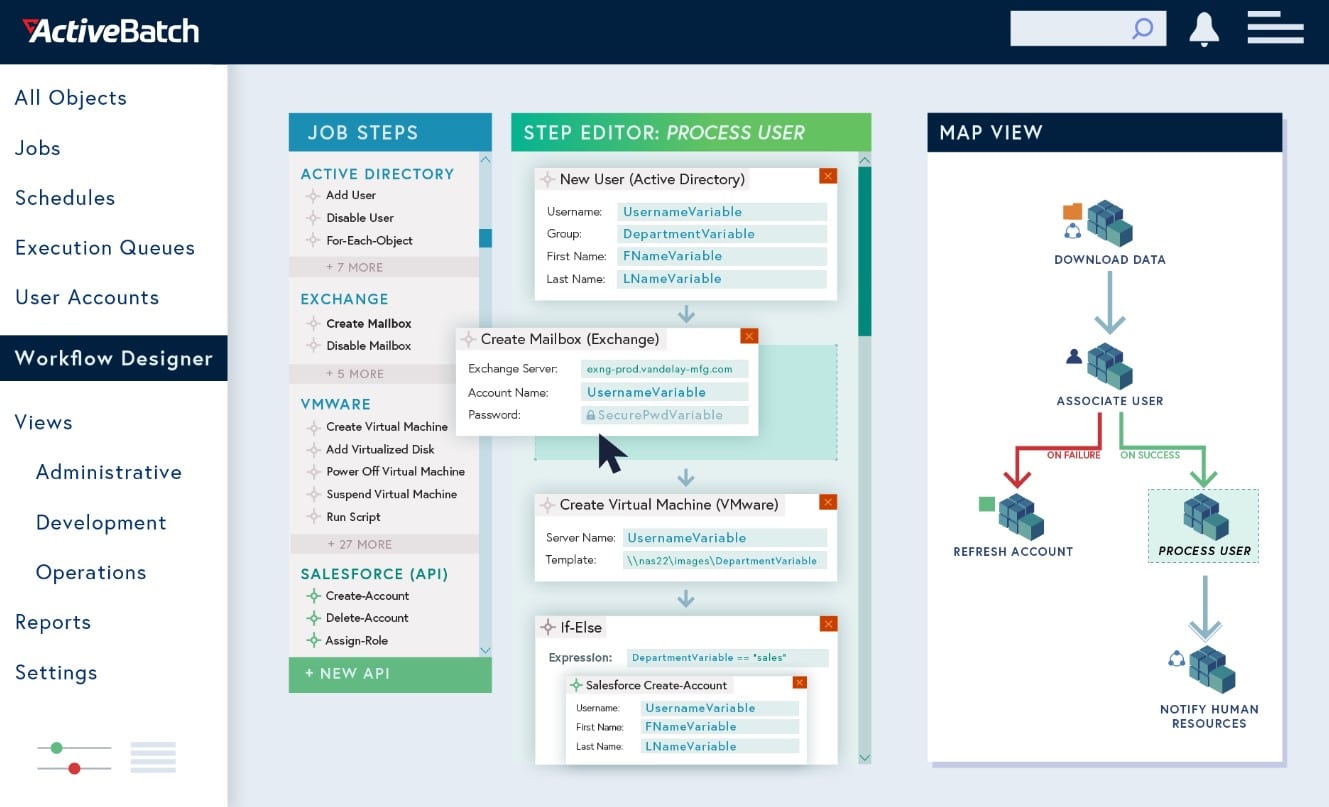
The signature product of Advanced Systems Concepts Inc., ActiveBatch is a robust automation system designed to help in a variety of use cases. The product’s ultimate aim is to be flexible in its availability to integrate into all aspects of your network infrastructure; this includes all of your servers, applications, and services—to fully automate your entire IT network. ActiveBatch excels in the complete diversity of compatible systems and comes pre-equipped with an enormous quantity of add-ons, extensions, and integrations.
The system provides hundreds of drag-and-drop operations, which facilitates complete business and IT processes so that they may be developed significantly faster than without automation. Advanced corporate task scheduling capabilities from ActiveBatch allow IT teams to streamline their process automation. Event triggers for business and IT workflows, including email, file events, FTP file triggers, and data updates, eliminate the need for manual duties. You can also utilize SLA monitoring and constraint-based scheduling, which decreases delays and boosts your overall service levels.
IT operations are monitored by ActiveBatch, which can be customized to alert users in the case of under runs and job failures. The system additionally provides real-time workflow monitoring and the creation of tailored reports that highlight ways to enhance IT operations. Using ActiveBatch you can maintain control of your network through dynamic alerts that start auto-remediation processes, which feasibly minimizes SLA breaches so IT can continue to concentrate on longer-term objectives.
However, ActiveBatch’s broad approach to many use cases could also be considered a negative. Without a defined specialization, ActiveBatch falls to the wayside of alternative products when considered for a single specific automation function. Therefore, ActiveBatch is best chosen if you need to cover a variety of different automation functions with a single central solution. If you only need to perfectly automate a single use case, then it might be best to investigate solutions designed for that exact use case.
You can request a full demo of all of ActiveBatch’s features from the website, you can find it alongside the contact form to get a quote on pricing. ActiveBatch features full guides on how to use their extensive integrations, and also how to migrate your existing systems into ActiveBatch.
The Best ActiveBatch Alternatives
1. Redwood RunMyJobs
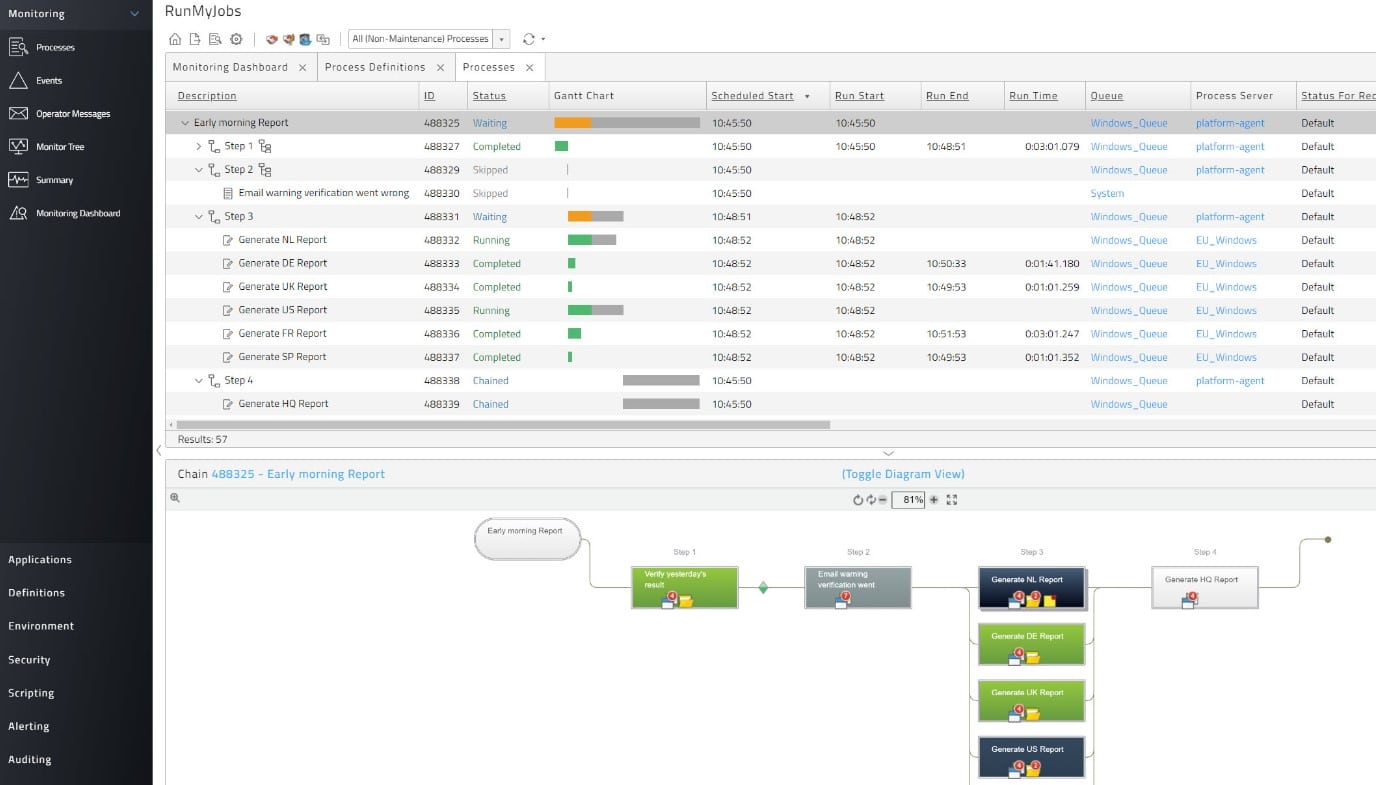
ActiveBatch is ultimately a product of Redwood, who themselves recommend their other product RunMyJobs as a direct alternative to ActiveBatch, with the Subscription as a Service (SaaS) model being their prime reasoning. RunMyJobs employs a consumption-based pricing model which means that you are only charged when the service is in operation, and the price is automatically adjusted based on your current operating scale. This is incredibly useful for businesses where flexibility and scalability are key concerns, which is often the case for organizations that utilize a lot of automation.
Key Features:
- SaaS Pricing Model
- Event-driven Process Automation
- Proactive Workload Monitoring
- Migration Assistance
- Cloud Infrastructure
Regardless of where your apps are hosted or what the underlying technologies are, every cross-platform procedure may be easily automated using Redwood's drag-and-drop focussed UI. You can use the system to automate controlled file transfers, dependencies, and real-time procedures across any on-premises or cloud-based endpoint. This also means you can coordinate and connect business process automation solutions, OS activities, API adapters, and legacy ERP systems seamlessly.
The system is ultimately designed from the top down to deliver high availability and maximum performance to manage enormous levels of activity across various systems and applications, while also allowing you to dynamically balance your workloads. RunMyJobs provides you with the means to establish regulations to lower risk during business process execution, and ultimately establish defined automated parameters for compliance.
In terms of real-time processing features, RunMyJobs provides you with the ability to quickly build processes using a low-code graphical editor that comes with a large library of integrated templates and wizards. Simple multi-step process chains can be easily created to run activities simultaneously for speedier completion. Additionally, preconditions can be customized, and branching pathways can be employed based on status, allowing you to integrate exception handling directly into your workflows.
As mentioned, RunMyJobs’ main draw is the SaaS pricing model that ensures flexible usage costs based on your exact business costs. To be more precise, the costs are directly dependent on the number of jobs you run.
However, Redwood doesn't provide any exact pricing comparison on the website without first requesting a quote directly from the company itself—this makes it somewhat more difficult to trust the SaaS model as a superior choice. Regardless, you can also request a demo of the product's features, and if you’re already running ActiveBatch, then be sure to mention it as they can provide ample support for making the shift towards RunMyJobs.
2. AutoSys Workload Automation
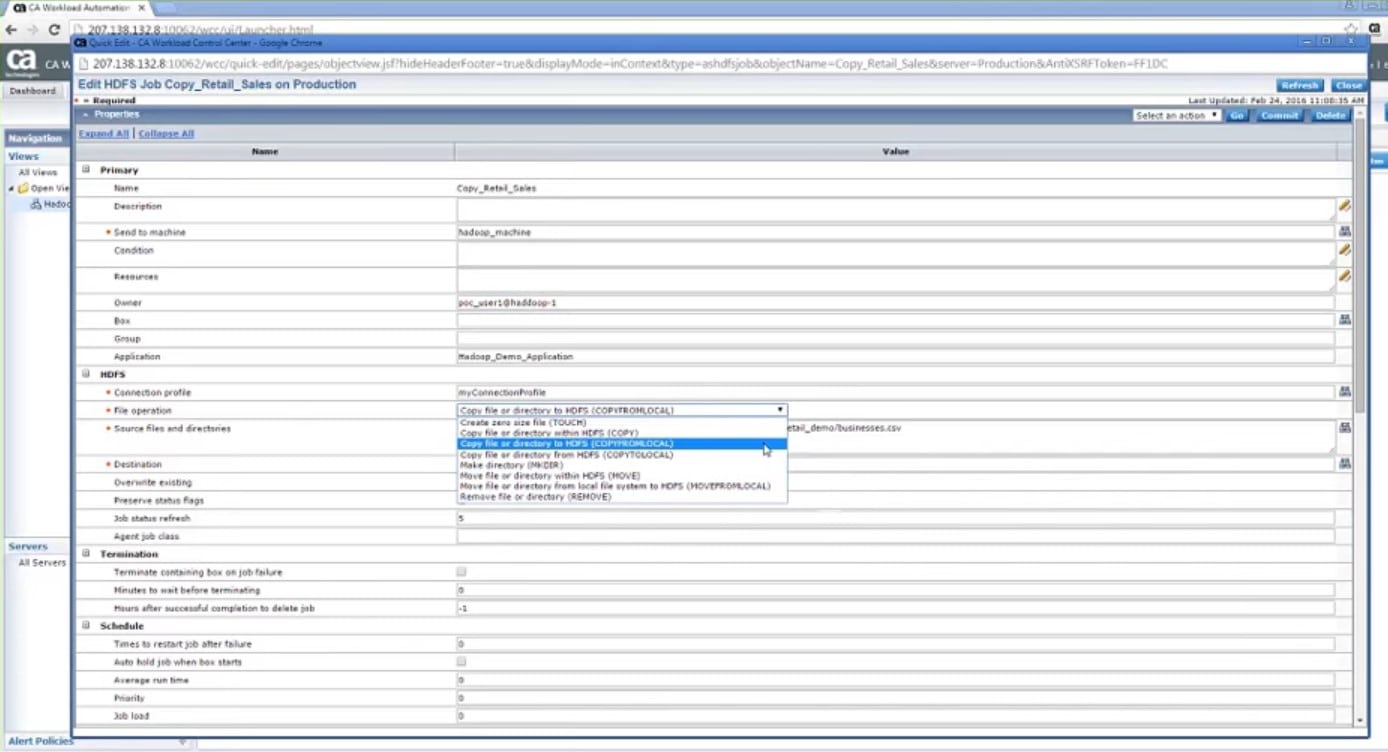
By dynamically responding to in-the-moment business events, aligning workload processes with SLAs, assuring ongoing monitoring, and automating recovery, AutoSys Workload Automation increases the availability of essential application workloads across your business. By offering a single point of control for managing and visualizing a business process end-to-end across platforms, the platform improves visibility and control. By intelligently and effectively assigning workloads based on real-time information about available computing resources and service level agreements, the system easily grows to enterprise demands.
Key Features:
- Multi-Platform Scheduling
- End-User Requests
- AI-Driven Insights
- Extensive Application Support
- Built-in Fault Tolerance
AutoSys Workload Automation employs end-to-end visibility of application workloads and dependencies across physical, virtualized, and multi-cloud systems. Real-time alerting, event-based triggering, and dynamic critical path management all work together to guarantee business applications are always available when needed. End users can make requests for and carry out workload processing that is governed by governance and policy procedures. In addition to increasing efficiency and management, this also gives your business as a whole more authority over your services, on a case-by-case basis.
By enabling tasks to be accomplished precisely and on time, reliable, lights-out operations with intelligent, automatic recovery improve your system availability. This selection of key features distinguishes AutoSys Workload Automation from its competitors by ensuring it offers a wide range of unique options—but another major draw is the Automic Automation Intelligence product.
This add-on to the foundational automation solution provides an array of additional insights that help you to better understand your infrastructure and improve your own ability to set automation parameters. To provide visibility into your workload in line with how your business is managed, the robust analytics platform effortlessly gathers real-time data from your workload automation engines. You keep historical data to spot abnormalities, streamline your schedule, and use that data to forecast outcomes in real time. By utilizing artificial intelligence to make use of such data, you may acquire greater insight into the workload processes that are essential to your company.
Broadcom does not provide any kind of free trial period or demoing for their services, though a demo might be available upon request depending on your business situation. Pricing is also only available upon request for a quote for the product. Both AutoSys Workload Automation and Automic Automation Intelligence are two separate products provided by Broadcom that can be integrated to function together—this does however mean paying for two products and will increase your overall costs.
3. Stonebranch
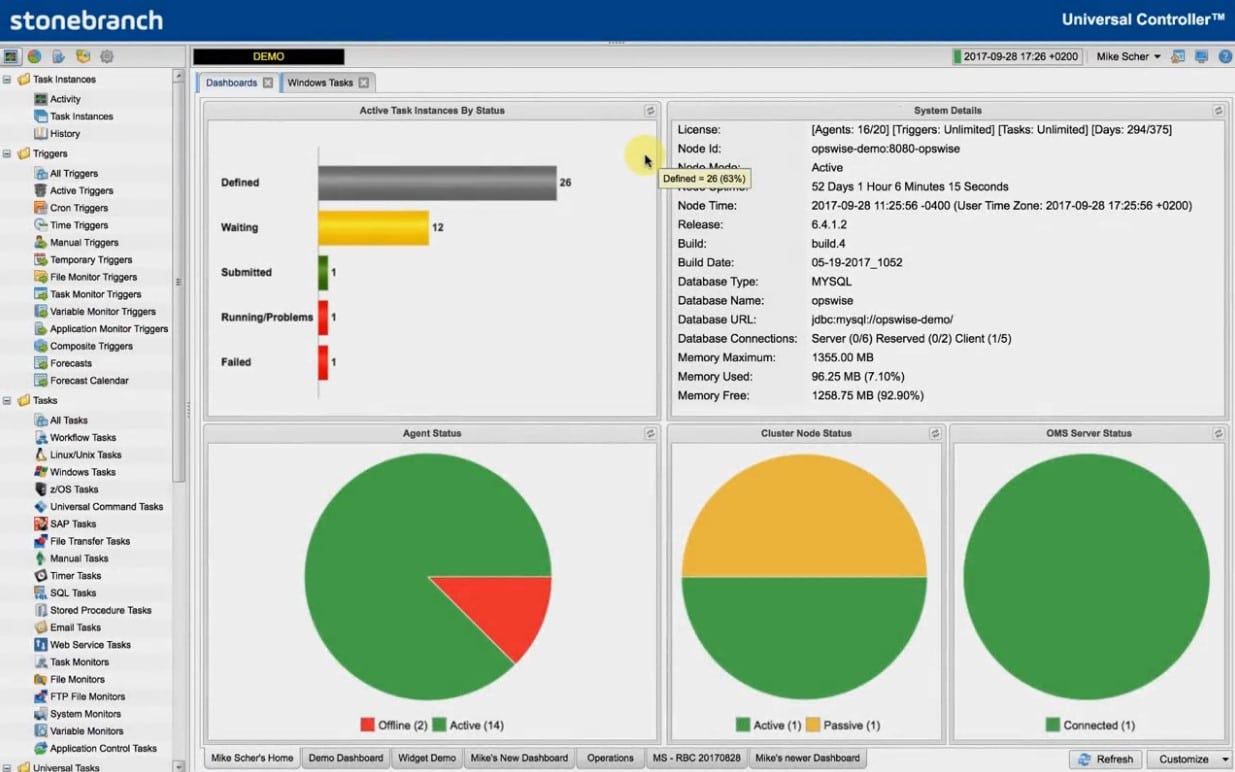
Stonebranch provides another SaaS alternative to ActiveBatch, with a set of similar features that are packaged through a highly intuitive user interface that makes the process of establishing automation throughout your business significantly easier. Stonebranch offers a wide array of pre-configured automation integrations for a variety of on-premises or cloud-based systems. For anything not already included, Stonebranch offers the typical API solution of self-made integration, however, there is also the Stonebranch Integration Hub which takes a community-driven approach to share API-scripted integrations—you can likely find an integration script for any commercially available product you are likely to set up with automation.
Key Features:
- Community-Driven API
- Straight-Forward UI
- Universal Agent
- Citizen Automators
- Universal Data Mover with Gateway
As mentioned above, Stonebranch is designed to focus on a low-code initiative, with a comprehensively straightforward UI-driven setup. This means the solution is probably the best for those not overly familiar with writing their own scripts and is the best option in terms of ease of use. Stonebranch also has a substantial amount of assistance for migrating, installing, setting up, and running the product from their website and community portal. The videos are thorough, and also provide a great way of demoing different features before committing to a purchase.
The system is divided into several individual components that are combined to make the full product. One such component is the Stonebranch Universal Controller (UC), which is a feature-rich centralized command center for IT orchestration and automation and is a component of the Stonebranch Universal Automation Center. You can utilize the role-based access to create citizen automators, which provide customized role-based user experiences that can be provided to LOB business users, analysts, and DevOps. This increases overall user adoption of real-time IT automation and frees up bandwidth for other IT operations.
Meanwhile, the Universal Data Mover (UDM) is a specially managed file transfer solution that supports businesses in their automation and transformation efforts by assisting them in orchestrating their data supply chain. UDM keeps track of data availability, starts business processes when data becomes available, and securely, reliably, and legally transfers data from any platform in any format. Peer-to-peer data transfers can be configured to be fault-tolerant across the network, preventing failures, user intervention, and restart needs.
Stonebranch has no free trial, and you will need to contact them directly for a price quote based on your business needs—since the product is SaaS this will be based on user or automation workload requirements on a flexible basis.
In terms of demoing the product, there are no advertised live demos, but as mentioned prior, there’s a comprehensive video assistance library with ample documentation. While it won’t suffice for your exact business needs, it should give you a good idea of exactly how well the service works for your needs. You should also check out the list of pre-configured integrations, and look at the Stonebranch Integration Hub to see what has been added, which will help you in determining if your existing services can be quickly integrated with the system.